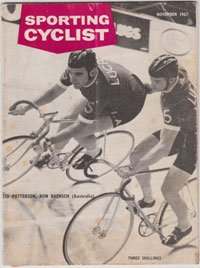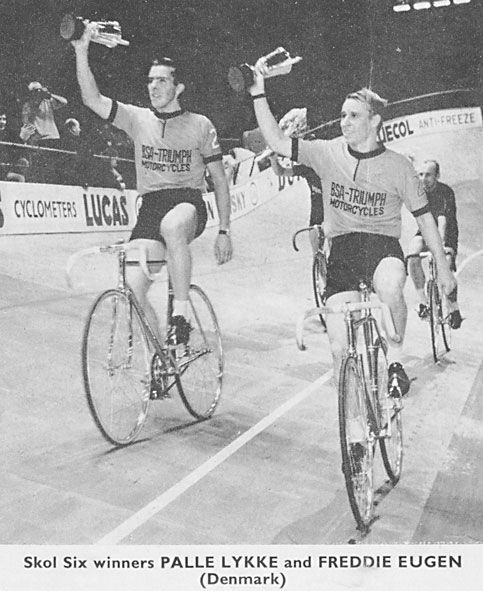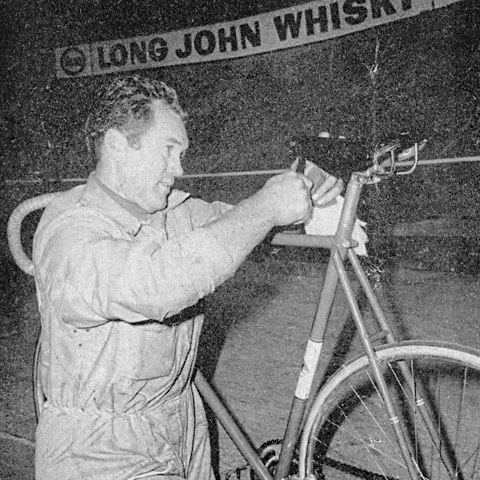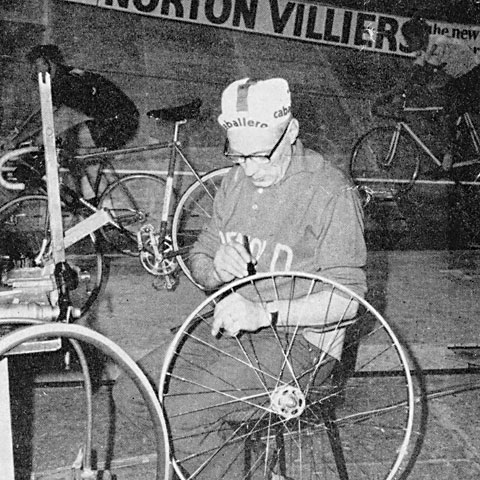 |
|
|
1967 - The Race Story - Part 2
|
|

|
|
Sid Patterson and Ron Baensch; Sporting Cyclist November 1967
|
|
Editorial
Credit: Sporting Cyclist, Nov 1967
"APOLOGIES first, if we were out when some of you looked in at "Sporting Cyclist's" Earls Court stand! The Show, and York Rally, gives us a fine chance to meet readers. As usual, we met plenty of friends old and new at the C.T.C.'s August rally. At the London Show, cyclists have been rather lost in recent years among the motor-bike boys, but with two big 1967 attractions, the concentration of the specialist frame and equipment dealers in Lightweight Corner, and the big draw of the "Six," Earls Court became a real cyclist's meeting place again.
My personal excuse for absenteeism from our stand during most of the Show was a certain "infection," one which spread during the week. The Editor, "vet" of over 30 "Sixes," told me he had virtually lived at the Wembley track in 1936 for his first "race to nowhere" as a journalist. "I bet you won't be away for many sessions!" he said with a knowing grin.
This was my first "home six," but I've seen several European ones, and besides I am about ten years older than was novice six-follower J.B.W. in the '30s . . . but I was "bitten" just as badly!
Hard to explain in words, or photos, the main factor that made me a backside captive; the same thing probably that had the crowds at some sessions jumping to their feet, cheering wildly. For it was not the efforts of one chief star, Post, or Lykke, or the crowd's darling, big Patto, or any particular peak spot of the racing. It was more the quicksilver thread that ran through all six days, the sheer mesmeric thrill of watching bikes ridden with such daring, skill, split-second timing and panache, in a setting that makes the impression of speed so breathtaking. If some facets of the Skol Six programme were open to criticism (inside, J. B. Wadley discusses it), it was run in a way that made the spectacle so vivid, quick-paced and clear-cut to help a crowd largely new to the game that I doubt if there were many who thought that their admission price was not full value afterwards.” ROY GREEN |
|
 'The Six mixture. . . was superb entertainment' 'The Six mixture. . . was superb entertainment'
by J. B. WADLEY
"WHERE'S Wadley?" they were asking down in the track centre several times during the Skol International six-day race at Earls Court.
Yes, they really were. Colleagues were wondering if, after my song of praise for the Six in last month's issue, I hadn't bothered to turn up to see the modern streamlined version of the sport started in London in the 1870s.
I was there all right. Not for all of the race, but certainly every night, and I spent most of the time as far away from the track centre as I could get, way up in the "gods," looking down as fascinated as I had been in my first glimpse of the magic at Olympia 33 years ago.
I looked down in wonderment because it was all so fresh and spectacular. Last month I expressed my doubts as to whether the modern formula of spending more time racing for points than for laps was desirable. Long before the final night at Earls Court I knew that the organisers had been right, and that the "mixture" was ideal for an audience that had, largely, never seen anything of the kind before. It was superb entertainment.
"Sporting Cyclist" readers, however, are not coming up against six-day racing for the first time. After a little primary instruction from our early issues many graduated to the continent and are now masters of the art of watching a six-day race. Others have not been so fortunate. but nevertheless went to Earls Court knowing the basic rules of the game; a third section had seen the Wembley races just before, or just after the second world war. A few had seen the two earlier Olympia promotions. Like me, they were all highly entertained by the tremendous skill of the experienced riders, impressed by the commentary team which kept the newcomers fully informed of all that was going on, and highly appreciative of the efforts of our five "novices" at the business.
Like me, they were satisfied to find that as well as being good entertainment, the Skol six ended with the two best teams finishing in the first two places, although many of us would say that the Germans were slightly better than the Danes, instead of the other way round. However, as in football and other sports, the better team does not always win.
We went away quite satisfied with seeing Peter Post finishing in third position. The new "King of the Sixes" was without doubt the strongest individual rider in the race, but he used his energy up in a series of spectacular shows behind the Raleigh mopeds, and we never saw the real Post in the chase. Moreover, even if Peter had nursed himself for the Madison sessions, I do not think young Koel is yet strong or experienced enough to have made them a winning team.
When, after only an hour and a quarter, Peter Post came down a cropper and hurt his arm and hip owing to the over-eagerness of one of our six-day novices, I thought he might prove an awkward customer for the rest of the week. In fact, Peter was superb. He, the accepted trackmaster, kept the race interesting and spectacular throughout, with the seven experienced teams always at the head of affairs, and the five other pairs - each with a British "novice" reasonably grouped a few laps back.
|
|

|
|
Above - Harry Hall of Manchester and below - Belgian Pierre De Bruyn; both mechanics at the 1967 Skol Six Day Race
Sporting Cyclist November 1967
|
|

|
|
On the last night, then, there were two races going on in the final Madison session; one for the first place, and the other for eighth, which the energetic Billy Holmes helped his partner Verschueren to take.
May I here make two confessions? When Charles Ruys first told me that he was planning to give every British rider a chance to prove his worth to ride the Skol "six," I was not very enthusiastic. I had seen too many failures in the past in the Wembley events - and many of these had been track riders. Most of the candidates for Earls Court were road-men.
Confession No. 2: on the opening morning at Earls Court, Roy Green asked if there were any particular photographic shots he should concentrate on. I replied that he must make sure to get pictures of all the "mixed" teams as soon as he could, because the British riders might not be there tomorrow.
How pleasant it was to be wrong! To watch up there from the "gods" our riders looking more and more like six-day riders every lap of the track; to hear the cheers and encouragement from the crowd; to watch their own private scrap a few laps behind the main battle; to share their relief when it was all over and they safely through—all except poor Hugh Porter who had fallen and broken his collar bone with two days to go.
In my office in Fleet Street on the Friday afternoon I was called to the telephone at 4 o'clock.
"Mike Breckon here," said a very clear voice.
"Where are you speaking from?"
"Montreal. Was anybody else injured in the crash that put Porter out?"
"Fortunately, no."
"How is Billy Holmes going?"
"Very well - but the best of the Englishmen is George Halls."
"Who?"
"George Halls! You can't believe it, I know. Before the race started we thought he would be the weakest of the five."
Mike was calling me from Montreal asking if I would take a message to Billy Holmes saying that he was being considered as a replacement for Hugh Porter.
I mentioned this telephone conversation for two reasons: (1) because Mike Breckon's astonishment was typical of the general reaction that George was riding so well; (2) because it was being said later that night that I had telephoned Montreal suggesting Holmes should take Porter's place!
The plain fact is that roadman George found he had the track coup de pedale which I wrote about in air Hour Record article earlier in the year - as good as Porter in this respect, and better than Holmes and Bonner (as a successful track rider, Hill must have had the coup de pedale in the first place).
Not that any of our four finishers has any illusions about his future as a six-day rider. They were in a privileged position at Earls Court, new boys who were given no rough treatment by the seniors and allowed to get on with their lessons. They were good pupils who more than justified Charles Ruys's faith in them, and they will have their part to play in any further, immediate, six-day races in Britain and a few minor ones abroad. Porter, on the other hand, has the basic class to take his place in a higher level of competition- and the extra speed acquired in the process could help him to a world pursuit win.
Britons had, of course, finished in six-day races and won them, long before Earls Court. All the same, Holmes, Halls, Bonner and Hill were possibly doing for British track sport what Brian Robinson and Tony Hoar were doing for the road in finishing the 1955 Tour de France.
Even so, the emphasis in a modern six-day race being on speed and spectacle, the future stars - foreign as well as British - of the smaller indoor tracks will have to be trackmen. Indeed, at Earls Court the only pure madmen in the line-up were Halls and Holmes.
I believe there are many fine potential six-day stars among our amateur trackmen. On the final night at Earls Court, before the big show started, I watched two of them, Ian Alsop and Tony Gowland taking laps as fast as many of the professional teams. They have, of course, had a lot of experience riding indoors in East Berlin. If the Skol track - or another - is available for training, amateur talent galore will surely emerge.
Everybody was delighted to see Bill Bailey, who broke his hip in March, fit enough to climb up and down the stairs and spend two night sessions in the track centre. The fourfold world amateur sprint champion - who is now 79 - has often told me how Piet Van Kempen came to be a six-day rider:
"Piet was a very good sprinter, who couldn't quite make the top. In Holland his way was barred by Pete Moeskops, and Van Kempen knew it was useless bashing away against him, or waiting for him to retire. So he took to six-day racing and became one of the greatest there has ever been."
In the track centre too, were Lloyd Binch and Karl Barton. Very fast, strong sprinters, winners of many national titles and international Grands Prix - but never quite there during world championships. Had there been an indoor track in Britain ten years ago, Binch and Barton, too, might have taken the six-day plunge.
Readers will remember that one of my reservations on the future of the professional class in Britain - a class declared overnight following the suppression of the independent category was that the leaning towards the Criterium and Promenade type of racing would never create real road-men. I now have to say that it will help discover men with the speed and staying power to become good performers on the indoor track. That is why the indoor velodromes ring to the cheers for Dutch, Belgian and German stars who spend their summers on the small open air, unbanked circuits.
This Skol International was, again, fine and spectacular, and just the stuff to serve up to the "outsiders" through whose support indoor track racing must to a large extent depend. It is paradoxical that while on the continent spectacle and variety have lately been added by six-day promoters to keep the custom of those who were finding the old formula monotonous year after year, we in Britain have had the icing served-up first. I believe the tit-bits must always be there, but I believe that in Britain, as nowhere else in the world, is there a demand for the fruity bit of the cake, too.
Newcomers to the sport were, naturally, thrilled to see five riders behind the Raleigh models. So were we - and are likely to be for a few more sixes yet. But when Britain eventually produces her own six-day stars there will be a case for cutting out some of the frills. By then - if the present track is still in use - it will be generally understood that a narrow ten-laps-to-the-miler is not really suitable for pace-following with the gloves off; that it is suitable for the three main six-day ingredients which, well mixed up in an indoor bowl will always thrill a crowd - jams, sprints, primes. Post was, rightly, applauded loudly for his great show behind the Raleighs; but the noise was even louder when Halls, Hill, Bonner and Holmes took their modest laps.
The pattern of the public, if it can be so called, was exactly the same as in all the London sixes I have seen: little enthusiasm in the early part of the week, better houses each succeeding night with a sell-out on the last with loud demands for another race as soon as possible.
But what a difference in the way the public was kept in the picture! At Wembley, when Union officials had to go into a huddle after every sprint, we used to get the result of the first sprint while the fourth was in progress. At Earls Court the David Duffield-John Ryan "tandem," working harmoniously with home and Belgian judges, had the result to us "direct."
The handling of sponsors' "plugs" and interviews with V.I.P.s was racy, but in good taste, the commentaries of the various competitions vivid and most helpful to the new six-day public. On the last point, however, there will come a time - we hope - when the British public knows as much about the sport as the announcers, and it will not be necessary to spell it all out in bold headlines well sprinkled with question and exclamation marks (I am told that in some parts of America where soccer is being seen for the first time commentators are telling the crowds all about comers, throw-ins, off-side rules, and the like, and giving life-stories of the players. Imagine that at Maine Road or Stamford Bridge!).
The Skol International Six was a great success - but it was a six without a personality. Oh how, in that respect, we missed Tom Simpson! Not so much in the serious parts of the proceedings - which obviously would have been even more exciting with his spirited riding - but in the "off duty" periods as well.
Indeed the enterprise missed Tom eleven days before the race even started when a Press presentation was held at the track. With Tom there, the papers would not have been as empty of six-day mentions as they were next morning - or the seats as empty for the first two days of the race itself.
Many times on those opening days, when the whole thing was still on a knife-edge, I thought how Tom could have saved the show. On the first morning, for instance, when Post was brought down after 75 minutes, there was an awkward pause of 30 minutes waiting for the pedal gashes on the track to be filled up (one of the handicaps of the new form of track construction; normally such a job takes about five minutes). The handful of spectators present were, naturally, restless at this delay, especially as they had already lost half an hour's racing time through the drawn-out starting ceremony. I'm sure Showman Tom would not have hidden himself in the cabin during that half-hour but amused himself, and the public by larking about on the track during this long neutralised period.
Tom's replacement, Sid Patterson, was a great success. Still the same old Patto, handsome, fast and tough as they come. Chatting with the track doctor one evening, I learned that Patto really was hurt in his fall and would have been justified in quitting. The formula of the race, was, of course, in his favour. At 40, in the picturesque words of Bill Bailey who was also racing at that age "Patio's backside will begin to dangle in a long chase." There were no really long chases at Earls Court, and the veteran Aussie was able to have spells recuperating in his cabin while other events were in progress. He was therefore able to get back up for the sprints and the primes with all his remarkable speed intact.
Full marks, too, to Ron Baensch, whose speed, tenacity and impeccable behaviour made him and Sid Patterson easily the most popular team of the week.
It has been said, by the way, that this was the first "real" London six-day race. Rot! Those at Wembley in 1936, '37, '38 and '39 were real enough. Come to that, Earls Court was the unreal one.
It was about as real a "six" as a football match is real in which teams may only score goals in a 15 min period of each half and spend the rest of the time trying to get corners and throw-ins so that in the event of a draw on goals, the match goes to the team with the most corners and throws. That might be fun, but they'd hardly use the formula in the World Cup!
Finally, into the "Suggestion Box" for the next six-day race in Britain I would put the following :
That each rider has also a big number on his back.
That each cabin has the name of its tenants printed in big letters above it. |
|
Original material from Sporting Cyclist magazine
|
|
|
|
|
|